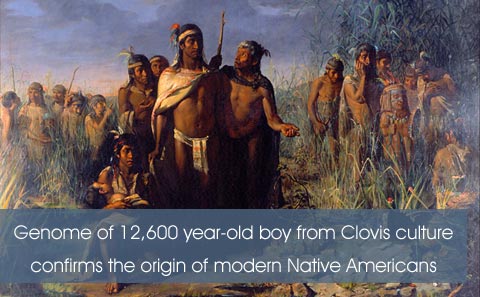
Rasmussen et al. tested the entire genome of a boy from the Clovis culture who died 12,600 years ago in Anzick, Montana. The results shows that all indigenous people in both North an South America seem to be descended from the same group of ancestors as those of the Clovis culture, which started c. 13,250 years ago. Clovis people are thought to have arrived to the Americas by crossing the land bridge from Siberia some 15,000 years ago.
The researchers compared the Anzick boy's genome with DNA samples from various Eurasian populations and 52 South American, Central American and Canadian tribes and found it to be most closely related to Central and South American populations, followed by Canadian tribes. The boy belonged to mtDNA haplogroup D4h3a, common among modern Amerindians. His Y-DNA is Q1a2a1 (L54, xM3), which is ancestral for Q1a2a1a1 (M3), the paternal lineage of modern Native Americans.
The Anzick genome was compared to that of the 24,000 year-old Mal'ta boy from Lake Baikal, to the 4,000 year-old Saqqaq Paleo-Eskimo from Greenland, as well as to the contemporary genomes of Karitiana and Mayan individuals. The Anzick-1 boy showed once again closer similarities with modern Native American (NA) populations than with the Mal'ta boy. Interestingly the Saqqaq Greenlander was intermediary between other NA and East Asians, and in fact closer to the Han Chinese to to the Anzick boy.
Unfortunately this genome won't give us an answer to the question of whether Europeans settled the Americas first during or immediately before or after the Last Glacial Maximum (26,000-19,000 years ago).
The earliest possible colonisation of the American continent might have taken place 30,000 years ago. The oldest skeletons in the Americas look distinctly more Europoid in their traits. Mongoloid features, present in modern Native Americans, suddenly replaced them from the time of the Clovis culture. This study confirms that Clovis was mongoloid and therefore also related to the modern Y-haplogroup Q1a and mt-haplogroups A, B, C and D of Native Americans.
It has been assumed that mtDNA haplogroup X2a, found exclusively in North America, was the last trace of the earlier European or Middle Eastern colonisation of the Americas. Y-DNA R1* has also been proposed, although there are only unconfirmed rumours of its existence among Native North Americans.
Notwithstanding the laudable accomplishment of sequencing a full ancient genome, it would have been far more interesting to choose a pre-Clovis sample to confirm the European, Middle Eastern or Siberian/East Asian identity of the first colonisers. I suppose that they started by the Clovis culture to avoid offending Native Americans by telling them that they are not descended from the Palaeolithic Americans.
The only solace I find is a hint of Irano-Gedrosian admixture in the Anzick-1 sample's K=11 admixture. The Anzick boy has nearly 100% of Native American admixture, 0% of Siberian, 0% East Asian (Chinese, Japanese), BUT 1 or 2% of the admixture that peaks in the Kalash, and is also found at high frequency in the Hazara, Sindhi, Balochi, Burusho, Persians, etc., and at a lower (10-15%) frequency in all Caucasian and European populations, except the Sardinians. This part of the original admixture of Y-DNA R, and could confirm that R1* was indeed present alongside X2a in the Upper Palaeolithic North American population that was replaced by the Clovis people.
Last edited:

